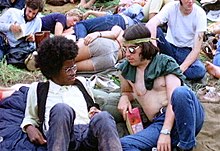Flower child

Flower child originated as a synonym for hippie, especially among the idealistic young people who gathered in San Francisco and the surrounding area during the Summer of Love in 1967. It was the custom of "flower children" to wear and distribute flowers or floral-themed decorations to symbolize ideals of universal belonging, peace and love. The mass media picked up on the term and used it to refer in a broad sense to any hippie. Flower children were also associated with the flower power political movement, which originated in ideas written by Allen Ginsberg in 1965.
Origins

The term originated in the mid-1960s in the wake of a film version of H. G. Wells's The Time Machine that depicted flower-bestowing, communal people of the future in a story characterized by antiwar themes. American political activists like Allen Ginsberg and Abbie Hoffman advocated the giving of flowers as a means of peaceful protest.[1][2][3] Images of flower-wielding protesters at the 1967 Pentagon March, such as Marc Riboud's image of Jan Rose Kasmir titled Flower Child [4] and Bernie Boston's Pulitzer prize-nominated photograph Flower Power,[5] popularized the association of flowers with the counterculture movement of the 1960s. Hippies embraced the symbolism by dressing in clothing with embroidered flowers and vibrant colors, wearing flowers in their hair, and distributing flowers to the public, becoming known as flower children.[6]
In an October, 1967 episode of Batman, Milton Berle portrayed Louie the Lilac, who tried to conquer all of the flower children, including Yvonne Craig's Barbara Gordon, aka Batgirl. This was one of the earliest mentions of the term in mainstream media.
San Francisco

John Phillips of The Mamas & the Papas wrote the song "San Francisco (Be Sure to Wear Flowers in Your Hair)" for his friend Scott McKenzie to promote both the Monterey Pop Festival that Phillips was helping to organise.[7] Released on May 13, 1967, the song's lyrics urged visitors to San Francisco to "wear some flowers in your hair", in keeping with the festival's billing as "three days of music, love, and flowers":
If you're going to San Francisco
Be sure to wear some flowers in your hair
If you're going to San Francisco
You're gonna meet some gentle people there
The song was a popular hit, reaching number 4 on the music chart in the United States and number 1 in the United Kingdom and most of Europe,[8][9] and became an unofficial anthem for hippies, flower power and the flower child concept.[10]
Summer of Love
After the January 14, 1967 Human Be-In organized by artist Michael Bowen (among other things, announcements told participants to bring flowers),[11] as many as 100,000 young people from all over the world flocked to San Francisco's Haight-Ashbury district, Berkeley, and other Bay Area cities during the Summer of Love.[1] in search of different value systems and experiences. The Summer of Love became a watershed event in the development of a worldwide 1960s counterculture when newly recruited Flower Children returned home at the end of the summer, taking with them new styles, ideas, and behaviors and introducing them in all major U.S. and Western European cities.
Social Analysis
In his book, Prometheus Rising, the philosopher Robert Anton Wilson suggested that the Flower Children could be viewed in Jungian terms as a collective social symbol representing the mood of friendly weakness.[12] In 1995, The Sekhmet Hypothesis extended Wilson's idea into other pop cultural trends with other youth movements being compared to the moods of hostile weakness, friendly strength and hostile strength.[13]
See also
References
- ^ "Allen Ginsburg", American Masters, Public Broadcasting System, pbs.org, retrieved 30-04-2009
- ^ "Guide to the Allen Ginsberg Papers: Biography/Administrative History" (PDF). The Online Archive of California. Stanford University. 1997. p. 3. Retrieved 2011-09-21.
- ^ Tony Perry, "Poet Allen Ginsberg Dies at 70", Los Angeles Times, April 06, 1997
- ^ Curry, Andrew (April 2004). "Flower Child". Smithsonian Magazine.
- ^ Bernie Boston, "Flower Power", The Washington Evening Star, October 21, 1967
- ^ Rennay Craats, History of the 1960s, Weigl Publishers Inc., 2001, p.36 ISBN 1-930954-29-8
- ^ Eddi Fiegel. Dream a Little Dream of Me: The Life of 'Mama' Cass Elliot. pp. 225–226. Retrieved 5 August 2013.
- ^ "U.K. Number Ones 1960-69". Rockmine Archives.
- ^ Whitburn, Joel (2004). The Billboard Book of Top 40 Hits: Eighth Edition. Record Research. p. 415.
- ^ McClellan, Dennis (August 21, 2012). "Scott McKenzie dies at 73". Los Angeles Times. Retrieved 13 January 2014.
- ^ Gene Anthony (1980). "The Summer Of Love - Haight-Ashbury At Its Highest" (PDF). ISBN 0867194219. Archived from the original (PDF) on June 6, 2007.
{{cite web}}: Unknown parameter|deadurl=ignored (|url-status=suggested) (help) - ^ Wilson, Robert Anton (1983). Prometheus Rising. Falcon Press. p. 55. ISBN 9781561840564. 'She/He is self-critical, shy, timid, easily led, "spineless," and always looking for somebody to Take Charge and Give Orders. The unearthly Angel, or in modern symbolism, the Flower Child'.
- ^ Spence, Iain (2012). The Hare Hypothesis. Bast's Blend. ASIN B009E2YUJM.
